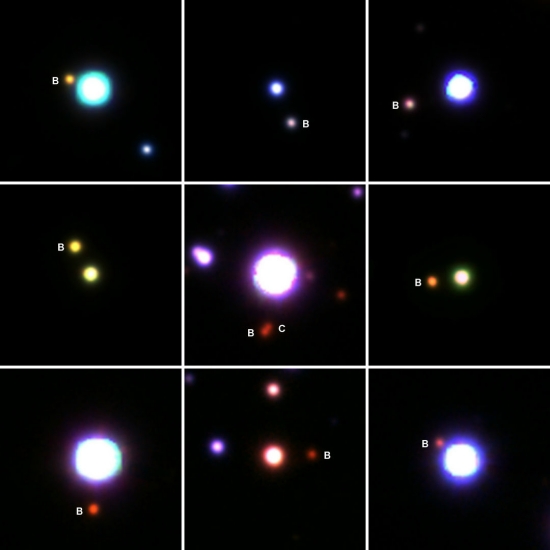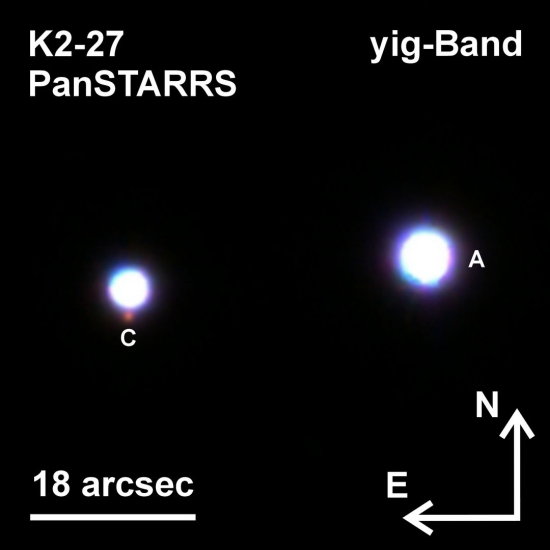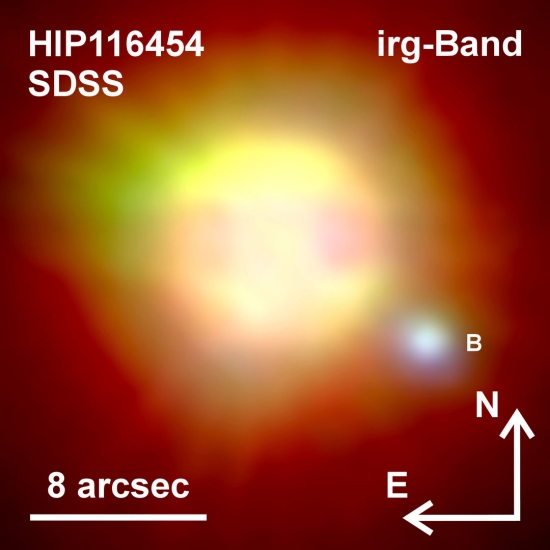While the majority of exoplanet-hosting stars discovered so far are single, we do have multiple star systems in various configurations with planetary companions. This is fertile ground for study, and not just because the nearest stellar system, Alpha Centauri, contains a tight binary pair that is being closely investigated for planets. The third star here is, of course, Proxima Centauri, around which we already know of the existence of a planet in the habitable zone. The much broader question is, how likely are multiple star systems to host planets?
Tackling this question in a new study is Markus Mugrauer (Friedrich Schiller University, Jena), who has been investigating how the existence of multiple stars in a system affects the formation and development of planets. Mugrauer has been working with the second data release from the European Space Agency’s Gaia mission (made available in April of last year). This release contains data collected by Gaia during the first 22 months of its mission. Mugrauer’s survey searched for stellar companions of 1367 exoplanet host stars within about 500 parsecs of the Sun, or roughly 1600 light years, as listed in the Extrasolar Planets Encyclopedia.

Image: These images show some of the exoplanet host stars with companion stars (B, C) that were found during the project. The images are RGB composite images taken with the Panoramic Survey Telescope and Rapid Response System (PanSTARRS) in the y- (960 nm), i- (760 nm), and g-band (480 nm). The image in the middle shows a hierarchical triple star system. Credit: Markus Mugrauer, PanSTARRS.
207 companion stars turn up in this work, varying strongly in mass, temperature and stage of stellar evolution. Of these, 176 are found to be binaries, 27 triple star systems, and one is a quadruple star system, which produces a multiplicity rate of about 15 percent. In each case, Mugrauer uses the Gaia data to demonstrate that the host stars are equidistant and share a common proper motion.
The heaviest of the companion stars weighs 1.4 solar masses; the lightest is a scant 8 percent of the Sun’s mass. As might be expected from their ubiquity, most companion stars turn out to be low-mass, cool red dwarf stars, although it’s interesting to note that eight white dwarfs are also found among the faint stellar companions. The projected separation between these exoplanet hosting systems ranges from 20 AU to 9100 AU, with the highest frequency being within 1000 AU (by comparison, the mean separation of Centauri A and B is 23 AU).

Image; A triple star system approx. 800 light years from the Earth in the Leo constellation with the planetary host star K2-27 (bright star on the left). The image is an RGB composite image taken with PanSTARRS in the y- (960 nm), i- (760 nm), and g-band (480 nm). To the right of it, the first companion star (A) can be clearly distinguished. Just below K2-27 is the second companion star (C) that glows faintly red. Credit: Markus Mugrauer, PanSTARRS.
The results point to what is likely the disruptive influence of several stars in a system where planets are forming, for Mugrauer’s 15 percent incidence of multiple star systems contrasts with the frequency of multiple systems in general. From the paper;
In order to compare the companion star fraction found in this study among exoplanet host stars to that of the solar like stars in general one has to consider only the range of projected separation of the companions detected here, i.e. 19 up to the applied search radius of 10?000?au. This requires the determination of the orbital periods of the detected companions, following the procedure, as described by Raghavan et al. (2010) for wide companions…
Working these calculations, Mugrauer comes up with the following:
The range of separation 19 up to 10?000?au corresponds to orbital periods log(P[d]) = 4.59–8.67. According to the period distribution of companions of solar like stars for this range of period one expect[s] a companion star fraction of 30 ± 2? per?cent, which is about twice as large as the fraction found in the study, presented here, among exoplanet host stars.
In other words, the frequency of exoplanet-hosting multiple star systems is about half what we would expect for solar-like stars in general, and the distances between companion and primary star in exoplanet systems are roughly five times greater than in ordinary systems. We may be looking at the gravitational influence of the companion on the gas and dust disk out of which planets emerge. Says Mugrauer: “These two factors taken together could indicate that the influence of several stars in a star system disrupts the process of planet formation as well as the further development of their orbits.”
Mugrauer’s work is continuing via an international observing campaign being conducted at the Paranal Observatory of the European Southern Observatory in Chile, which will apply data from Gaia to more precisely characterize newly discovered planetary host stars and their companions.

Image: HIP116454 is a planetary host star in the Pisces constellation and it is approx. 200 light years from the Earth. The star is accompanied by a significantly fainter white dwarf (B). The image is an RGB composite image composed of images taken in the i- (760 nm), r- (620 nm), and g-band (480 nm) as part of the Sloan Digital Sky Survey (SDSS). Credit: Markus Mugrauer, SDSS.
The paper is Mugrauer, “Search for stellar companions of exoplanet host stars by exploring the second ESA-Gaia data release,” Monthly Notices of the Royal Astronomical Society 13 November 2019 (full text).



It makes sense that multiple star systems would not be a fertile ground but their creation may not all be so similar.
Taking into account only binaries and restricting ourselves to K to F5 type stars, do we know if stars in stellar nurseries that are born close to each other are created from the same local gas concentration implying that the second star was part of that gas volume,
OR is it the case that SOME binary star systems come to
be because of stellar drift AFTER the proto-planetary disk is showing
gaps indicating protoplanets?. If significant percentage of binaries are of the latter type, then we should expect some planets to form even with
a companion star at say Saturn-Neptune orbital distances. These systems may allow rocky planets to form at the Venus-Eart orbital distances. The other side of the coin is that for stars of binary formation forming form the same local gas volume only a very close in small planet maybe possible and are probably very rare.
It depends on the distance between the two binaries. If they are really close Kepler 47 it makes sense they might have exoplanet, but I have been curious of what the astrophysics is when the binary system is a Saturn or Neptune distance apart. Alpha Centauri A and B fits into those parameters. Intuitively, I think there are no rocky planets around that system, at least no Earth sized ones, but that is not physics though. At some point the distance between two stars makes it impossible for planets to form in a life belt around either star since they are to close and any protoplanetary gas and dust are in an unstable orbit or there is too much disruption of the disk making it difficult for the planets to form at a certain distance exactly halfway between the two stars. It also depends on the mass and type of the two stars.
I was just reading https://dailygalaxy.com/2019/11/milky-ways-quadrillions-of-rogue-interstellar-planets-could-be-life-bearing-weekend-feature/ which says something that in retrospect should have been obvious: if Earth went rogue, it would continue to be inhabited, at least by microorganisms that rely on geothermal energy sources (and of course perhaps by a few survivalists worthy of being made protagonists).
If rogue planets are truly numerous and could be teeming with life, then an inhabited planet might turn up around any multiple star system … at a certain distance, at least. Maybe binary systems might also be better at catching rogues (and setting them loose) at closer orbits because of multiple-body effects?
I wonder if there will eventually be enough simultaneous monitoring of occultations from orbit that rogues can be tracked near the Solar system.
Interesting article about planetary systems clustering that makes earth like planets a common object around most FGK stars! See section 4.3, this should also make for many earth like planets in the stable orbit zone around most Multiple-Star Exoplanetary Systems including Alpha Centauri A and B.
Architectures of Exoplanetary Systems. I: A Clustered Forward Model for Exoplanetary Systems around Kepler’s FGK Stars.
From section: 4.3 Implications for the fraction of stars with planets.
“Earth-sized planets: We provide results for the rate of Earth-
sized planets (here defined to be 0.75–1.25 R ? ) around FGK stars,
using our clustered periods and sizes model. The fraction of stars
with at least one Earth-sized planet (between 3 ? 300 days) is
0.42 +0.24?0.16 . The mean number of these planets per star is 0.85
+0.51?0.30 . Considering systems with at least one planet (with sizes between 0.5 and 10 R ? and periods between 3 and 300 d), the probability that a planetary system contains an Earth-sized planet (in the same period range) is 0.75±0.14. If we focus on planetary systems with at least one planet (not necessarily Earth-size), then the mean number of Earth-sized planets per system is 1.62 +0.23?0.38 (both with periods 3–300 d). Broadly, about half of stars have an Earth-sized planet and most inner planetary systems have Earth-sized planets. Due to the increasing frequency of planets at longer periods, most of these
Earth-like planets are in 100–300 d orbits.These conclusions follow
directly from combining the inferred distributions for orbital period
and planet radius (that are consistent with previous results) with the
inferred fraction of stars with planetary systems.”
https://arxiv.org/abs/1907.07773
Stable planetary systems orbits around Alpha Centauri A/B.
http://i0.wp.com/www.scifiideas.com/wp-content/uploads/2011/03/alphac_ab-c.gif
The eccentric orbit of Alpha Centauri A and B, with the orbits of the Solar System’s planets for scale.
https://planetplanetdotnet.files.wordpress.com/2014/11/alpha-centauri-b-orbit.jpg
Extent of the (optimistic) habitable zones around Alpha Centauri A and B.
https://planetplanetdotnet.files.wordpress.com/2014/11/alphacen_hzs.jpg
Remarkably inexpensive mission could find planets around the nearest sun-like stars.
https://medium.com/starts-with-a-bang/remarkably-inexpensive-mission-could-find-planets-around-the-nearest-sun-like-stars-4b36870c1ef7
Alpha Centauri A and B stable orbit limits and habitable zone in arc seconds as observed from Earth.
https://miro.medium.com/max/1680/0*cO5li3amYvQ5qc5X.
I don’t think we will find any Gas giants around Alpha Centauri A and B because the two stars have attracted and grabbed all the gas so there is not a lot left for gas giants because the two stars are too close together. There might be enough left for an Earth sized planet though.
I was thinking about the ring model idea of binary star system formation. P. 234, Kippenhahn, 1983, p. 234. 100 Billion Suns. A ring of matter forms first on opposite sides of the ring. After 100,000 years, “the ring disintegrates into two concentrations” which turn into two stars which revolve around each other. Ibid., P. 234 The stellar matter retains the angular momentum in double star systems with the ring model unlike single star systems which grab most the angular moment from the single star. Ibid., P. 237
If the angular momentum is retained until the stars form there can’t be any gas giants which have to form earlier. There is no mention whether or not there can be any planets, but it might be harder for them to form with a smaller region of space around each star for a effective heavy bombardment period?
Maybe there’s been a study of this but:
Do the spin axis’ of binary star system correlate to each other.
If the spin axis differ 45 deg or more, can we say it is likely
that both stars were born very close to each other, but NOT of the same
gas volume?
ArXiv.org/abs/1911.o7355 “An extremely low density and temperate exoplanet.” by A. Santerne et al. K2-93(or HIP 41378)f has the following parameters: radius = 9.2 Earth radius(or ~1 Saturn radius), Teff = ~300 Kelvins, mass = 12+/- e Earth mass, density = ~0.09g/cm3. The authors mention the good possibility that since the star’s flux is FAR TOO LOW for stellar radiation to inflate the planet via stellar radiation, the CAUSE of the “inflation” is the presence of a giant version of Uranus’s ring system completely devoid of ice due to the ~300K stellar flux. MT TAKE: for this to be so, two Mars-sized moons must have collided VERY RECENTLY, completely destroying themselves in the process. I find this very hard to believe, because the speed at which they both orbit the planet would be far too slow for this to happen, and the FAR MORE LIKELY OUTCOME would be that they simply coalesce into a single moon. That leaves the intriguing possibility that this is an 11 =/- mini Neptune orbited by a ~1 Earth mass moon with a mini(relative, of course)Dyson shell surrounding BOTH THE PLANET AND THE MOON in an effort to reduce the temperature enough to make the moon habitable. Since the star is only 2.7 billion years old, based on our own planet’s biological history, it seems unlikely that ETI could have ORIGINATED in this system, leaving the intriguing possibility of colonization.
OOPS: I meant +/-3, not +/-e(or just +/-).
arxiv: 1606.08441 “Five Planets Transiting a Ninth Magnitude Star.” by Andrew Vanderberg et al. This is the discovery paper. Click on the PDF and scroll down to “fig 2”. I see ABSOLUTELY NO EVIDENCE fir either exomoons or exorings(unless it is ABSOLUTELY FACE ON WITH NO GAPS WHATSOEVER) in the single transit light curve of K2-93f(correct me if I am wrong, but it appears to be a PERFECTLY SPHERICAL OBJECT)!
The next transit for K2-93f is THIS SUNDAY NIGHT! VLT-ESPRESSO WILL be monitoring the transit. Hopefully Hubble and Spitzer can get in on the act, too.
https://arxiv.org/abs/1911.05068
The Vanishing & Appearing Sources during a Century of Observations project: I. USNO objects missing in modern sky surveys and follow-up observations of a “missing star”
Beatriz Villarroel, Johan Soodla, Sébastien Comerón, Lars Mattsson, Kristiaan Pelckmans, Martín López-Corredoira, Kevin Krisciunas, Eduardo Guerras, Oleg Kochukhov, Josefine Bergstedt, Bart Buelens, Rudolf E. Bär, Rubén Cubo, J. Emilio Enriquez, Alok C. Gupta, Iñigo Imaz, Torgny Karlsson, M. Almudena Prieto, Aleksey A. Shlyapnikov, Rafael S. de Souza, Irina B. Vavilova, Martin J. Ward
(Submitted on 12 Nov 2019 (v1), last revised 21 Nov 2019 (this version, v2))
In this paper we report the current status of a new research program. The primary goal of the “Vanishing & Appearing Sources during a Century of Observations” (VASCO) project is to search for vanishing and appearing sources using existing survey data to find examples of exceptional astrophysical transients. The implications of finding such objects extend from traditional astrophysics fields to the more exotic searches for evidence of technologically advanced civilizations.
In this first paper we present new, deeper observations of the tentative candidate discovered by Villarroel et al. (2016). We then perform the first searches for vanishing objects throughout the sky by comparing 600 million objects from the US Naval Observatory Catalogue (USNO) B1.0 down to a limiting magnitude of ?20?21 with the recent Pan-STARRS Data Release-1 (DR1) with a limiting magnitude of ? 23.4.
We find about 150,000 preliminary candidates that do not have any Pan-STARRS counterpart within a 30 arcsec radius. We show that these objects are redder and have larger proper motions than typical USNO objects. We visually examine the images for a subset of about 24,000 candidates, superseding the 2016 study with a sample ten times larger.
We find about ? 100 point sources visible in only one epoch in the red band of the USNO which may be of interest in searches for strong M dwarf flares, high-redshift supernovae or other catagories of unidentified red transients.
Comments: SETI meets time domain astronomy. Accepted into the Astronomical Journal
Subjects: Earth and Planetary Astrophysics (astro-ph.EP); High Energy Astrophysical Phenomena (astro-ph.HE); Solar and Stellar Astrophysics (astro-ph.SR)
Cite as: arXiv:1911.05068 [astro-ph.EP]
(or arXiv:1911.05068v2 [astro-ph.EP] for this version)
Submission history
From: Beatriz Villarroel [view email]
[v1] Tue, 12 Nov 2019 18:51:38 UTC (9,695 KB)
[v2] Thu, 21 Nov 2019 13:17:32 UTC (9,695 KB)
https://arxiv.org/pdf/1911.05068.pdf